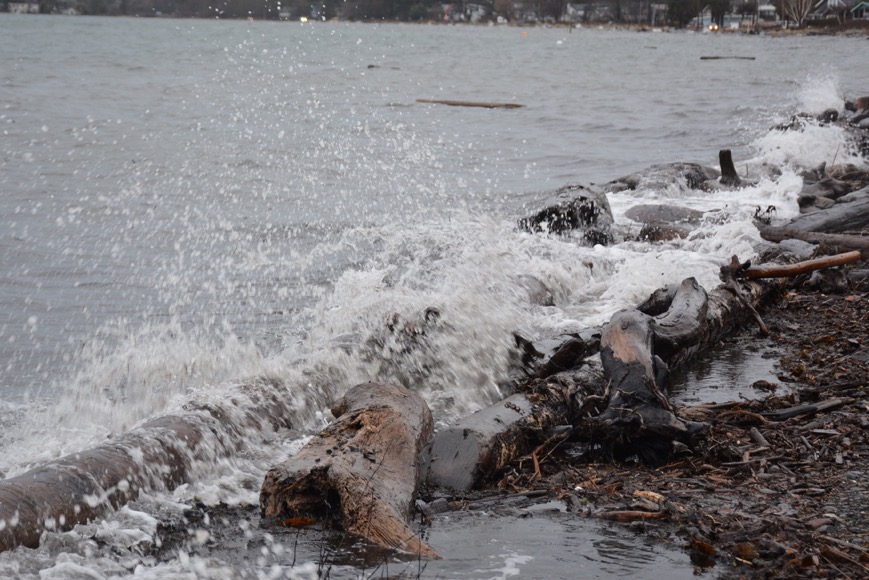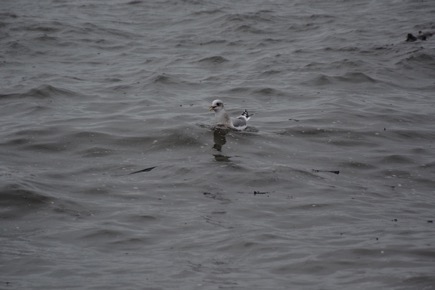High Water
28/12/22 01:35

Yesterday, we went down to the beach to look at the king tide. The water was so high that the bay was full to the breakwaters and berms. The tidal creek was overflowing its banks, flooding streets and, in one place, flowing over a bridge. There were a few cars that had been stranded in water too deep to drive. Some of the beach cottages had water in them, as well as some of the buildings near the creek. We also saw standing water in low places, flooding buildings that were a couple of blocks back from the beach. The winds were nearly calm in the morning, so the waves weren’t splashing that high. Because we remember the king tides from last winter, we were not surprised by the water levels. Still, it was very interesting to see what was happening, and we took a second walk later at the day, near low tide, just to see the difference. A lot of logs were floated around the bay. There were lots of new shells washed up onto the beach, including clams, oysters, and crabs.
In the morning, however, we were simply looking at the high water and seeing all that was happening. While we were down by the shore, we struck up a conversation with a woman whom we had not previously met. She informed us that she lived in a beachfront house a short distance from where we were standing. We asked if she had water in her house, and she said “not yet,” but she was sure that if it were windy and the waves were higher they might. They have a rock breakwater in front of their house and she thought the water was the highest she had seen. I commented that the measured tide was a bit lower than the highest tide during last year’s king tide. She was skeptical about that. She said they had lived in their house for two and a half years and this was the highest that they have seen. During our brief conversation, she commented over and over, “This is insane!”
I don’t think she was referring to her present state of mind. In fact, I don’t think that she was using the word “insane” in its technical definition, but rather in the informal sense of “shocking or outrageous.” At least I don’t know how one could attribute human characteristics to the movement of the tides. If so, saying that the natural world is “in a state of mind which prevents normal perception, behavior, or social interaction” seems out of place when the tides can be forecast in advance and charts predict the flows accurately. I’m going with the interpretation that she meant “outrageous.”
The tides, however, are not outrageous. They are not insane. When we retired two and a half years ago and moved to Northwest Washington, we were aware of global warming, sea level rise, and the risks of coastal flooding. Surely they must have known, when they purchased their oceanfront property that sea level rise and flooding were an issue. Is it possible that they purchased their home not knowing about king tides? Since we moved, we have been careful to look at the flood ratings of each property we considered, including the home we rented. Last spring my family’s recreational property on a river in Montana experienced a 500 year flood without getting water inside the buildings. It seems hard for me to believe that people are shocked and surprised by the natural cycles of tides, weather, and water.
This world may be changed by the processes of human over population and over consumption. Global weather changes may be in part the result of human decisions and behavior. But the world is not insane. Nature does not have a severely disordered state of mind. All around the globe people are experiencing the instability of changing sea levels. Beachfront properties may not be the wisest of investments in such conditions.

There are ways to engineer and build above the level where water and mud flow. Those solutions may be expensive, but they do exist. Over the summer we watched as a brand new beachfront cottage was built on an empty lot by the bay. In accord with the current building code, after concrete footers were poured, foundation walls rose above the ground six to eight feet. Then that space was filled with dirt and the dirt was compacted leaving a crawl space under the joists of the new building. It stands higher than its neighbors, with a set of steps taking people up from ground level to the first story of the new cottage. The day will come when the water rises, flooding the neighbors. Hopefully the new cottage will be above the flood.
We find the rising and falling of the tides and the flooding of king tide season, especially when the creeks and rivers are already at flood stage, to be interesting. I wouldn’t, however, call it “insane.”
REGULAR READERS PLEASE NOTE: For the next eight days, we will be traveling. Although I will write my journal daily and we will be going to a place where we have Internet access, I am uncertain of what time I will be publishing my journal over the next week or so. Since we are traveling from Pacific Time Zone to Eastern Time Zone, our sleep schedule will be disrupted. I may not publish every day. Don’t worry if you don’t find the journal posted at its typical time. Check back later and I’ll eventually catch up.
